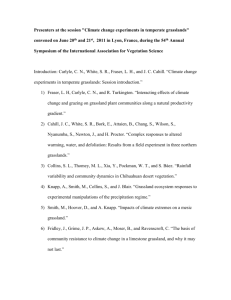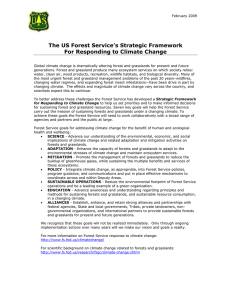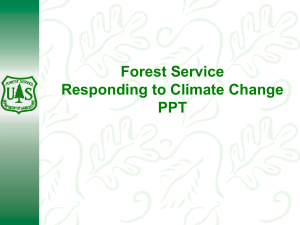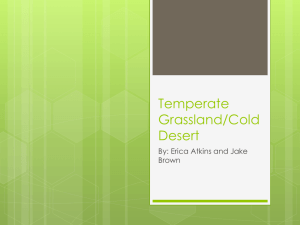NATIONAL GRASSLANDS MANAGEMENT A PRIMER Appendix B
advertisement
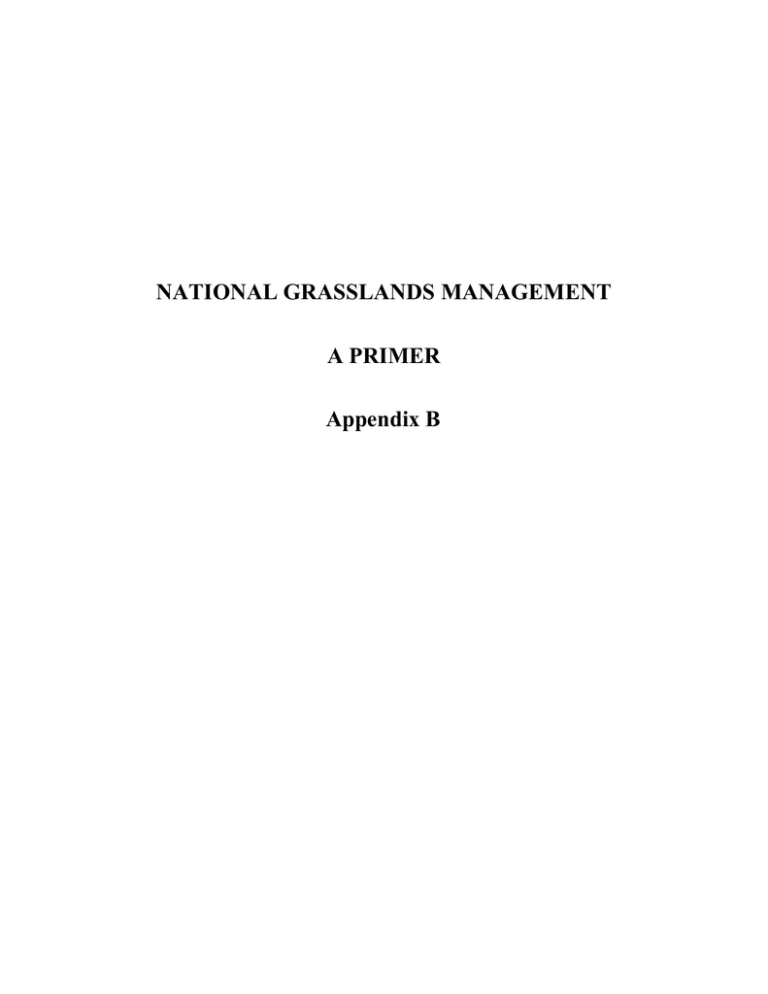
NATIONAL GRASSLANDS MANAGEMENT A PRIMER Appendix B NATIONAL GRASSLANDS MANAGEMENT REVIEW ACTION PLAN USDA – FOREST SERVICE APRIL 1996 Approved /s/ Janice McDougle Janice McDougle Associate Deputy Chief, NFS Date 5/8/96 Approved /s/ Ronald E. Stuart for Jerry A. Sesco Deputy Chief, Research Date 5/8/96 4/26/96 NATIONAL GRASSLANDS1 MANAGEMENT REVIEW ACTION PLAN USDA – FOREST SERVICE APRIL 1996 INTRODUCTION: This action plan was prepared in response to a management review of the national grasslands conducted on October 30 through November 7, 1995. The review team was interdisciplinary and made up of Forest Service employees from the Washington Office and the field as well as a representative from the Natural Resources Conservation Service. The team was led by the Associate Deputy Chief of the Forest Service for National Forest System. The actions contained in the plan are those which affect more than one Forest Service region. Other actions, as needed, which apply to specific units and programs will be contained in action plans prepared by individual Forest Service regions and research stations. The findings and desired futures listed in the action plan are taken from the “Report of the National Grasslands Management Review Team, USDA Forest Service, October 30 – November 8, 1995.” The report is dated December 26, 1995. The review team or subsequently designated representatives will assess overall progress in meeting action plans and file a report with the Forest Service Chief on or before January 1, 1997 and 1998. Representatives from the review team will make a series of small group visits to a cross section of national grasslands to interact further with employees and users in a field environment to demonstrate increased emphasis and commitment to national grassland management, and to make continual adjustment in management actions. A. POLICY FRAMEWORK Finding 1: Legislation and policy applicable to the national grasslands are not uniformly understood or accepted internally or externally. A common and shared vision for management of the national grasslands is lacking. Finding 2: Policy direction specifically related to managing the national grasslands needs strengthening. Finding 3: The national grasslands need to be used more frequently and effectively to demonstrate and influence sound and practical management of grassland ecosystems. 1 Transcribed from original for legibility. (1) Desired Future 1. Creation of a commonly understood vision for the national grasslands. The vision is available for implementation in the revision of land and resource management plans applicable to the national grasslands. 2. A commonly understood vision is used as a foundation for making adjustments as needed in regulation and national, regional, and local policy. 3. Grasslands are considered showcases for demonstrating sound land management practices. Actions 1. Identify legal issues and clarify the intent of the Bankhead-Jones Farm Tenant Act (BJFTA) as originally passed and with subsequent amendments and related legislation, including a statement of applicability of other laws (i.e., Multiple Use-Sustained Yield Act, Endangered Species Act, National Forest Management Act, and other environmental laws) to the national grasslands. Prepare a white paper to be used in gaining consistent interpretation. WHO: Forest Service Washington Office and Office of General Counsel WHEN: 10/1/96 2. Develop a common national grasslands vision. WHO: Forest Service Washington Office and National Grassland Council WHEN: 03/01/97 3. Articulate and implement the vision through a communication plan directed at gaining a clear and common understanding of direction applicable to the national grasslands. WHO: Forest Service Washington Office and National Grassland Council WHEN: 03/01/97 4. Based on A1. and A2 -Determine need for updating Forest Service Manual, including Conservation Practice guidelines. Determine whether changes are need in Code of Federal Regulations to be consistent with items A1. and A2 WHO: Forest Service Washington Office and National Grassland Council WHEN: 07/01/97 (2) 5. National Grasslands Rangers and Forest Supervisors meet annually to coordinate understanding of policy, share strategies for resolving issues, and other matters. Provide appropriate opportunities for external interests to be involved. WHO: National Grasslands Council WHEN: 12/1/96 and annually thereafter with periodic evaluation of the need for continuation. 6. Develop the criteria for an orientation package for employees on the national grasslands and a general information package for other employees to promote understanding of laws, regulations, history, and processes. WHO: National Grassland Council WHEN: 1/1/97 7. List potential areas and projects for opportunities to demonstrate sound land stewardship and ecosystem management principles for each national grassland. WHO: Forest Supervisors WHEN: 1/1/97 8. Initiate a coordinated environmental education program for national grasslands highlighting their origins, purposes, resources, uses, and importance to bio-diversity. WHO: National Grassland Council WHEN: 1/1/97 B. WORKING WITH OTHERS Determine the extent and effectiveness of involvement of users, state and local governments, tribal governments, other partners, and the public. Finding 1: The Forest Service needs to exert greater leadership in interagency, intergovernmental, and Tribal government collaboration. Finding 2: The Forest Service is not as effective as it could be in bringing varied interests together, providing opportunities for input, and involving them in solutions. In some cases, our coordination and collaboration are too narrowly focused. Finding 3: The Forest Service needs to be more active in coordinating and sharing resources with other USDA agencies and doing more to support common USDA goals. Desired Future 1. The Forest Service is seen as exercising a greater level of conservation leadership in the area of the national grasslands. (3) 2. Written commitment(s) are developed with appropriate Federal and State agencies and others to achieve specific outcomes, including timeframes and strategies to be employed. 3. A management environment where all grassland interests believe that their views and concerns are considered in natural resource decisions. National grassland leadership creates a forum or process to utilize public input into grassland policies, programs, and projects. Other Federal agencies, States, local governments, and grassland interests are utilized in the development and assessment of grassland policies. 4. National grasslands skills are acquired from a variety of external sources, including NRCS and are available at the right place and the right time. 5. USDA agencies clearly understand each other’s missions and can articulate these missions within the community of interests. It is readily apparent to local residents that the agencies are mutually supportive and work in a complementary fashion. Actions 1. Develop a coordinate stakeholder list and assign responsibility for contacts. WHO: Forest Supervisors WHEN: 1/1/97 2. Designate a Regional Forester to participate as part of the Great Plains Partnership of the Western Governors’ Conference. WHO: Chief WHEN: 6/1/96 3. Appoint a representative to appropriate Western Governors’ Conference working group(s). WHO: Chief WHEN: 6/1/96 4. Develop a mechanism for coordinating work, sharing personnel and equipment with associated USDA and other agencies, which will improve management efficiency and promote interagency understanding of agency missions. WHO: All Regional Foresters. WHEN: 12/1/97 5. Develop a mechanism in coordination with other agencies and native american coordinators for collaborating with tribal governments across administrative boundaries. WHO: National Grassland Council (4) WHEN: 12/1/96 6. Host an annual national grasslands tour for interest groups and agencies to promote understanding of on-the-ground management and to encourage formation of common ground partnerships. WHO: National Grassland Council WHEN: Summer 1997 7. Develop and implement a communications plan that insures that all interests and other agencies are given the opportunity to be involved in the Northern Great Plains Plan revision process including data collection, interpretation and use. WHO: National Grassland Council WHEN: Ongoing 8. Expand the use, beyond the Northern Great Plains, of an interagency working group to coordinate collection, sharing and interpretation of resource data in the Great Plains. WHO: National Grassland Council WHEN: 6/15/97 9. Each national grassland identify local Resource Conservation and Development projects to strengthen ties and improve efficiency among Natural Resource Conservation Service, national grasslands, and local communities and offer appropriate Forest Service assistance. WHO: Forest Supervisors WHEN: 1/1/97 C. EFFECTIVE ORGANIZATIONS Finding 1: Many people expressed the concern that national grasslands are treated disparately with national forests in terms of emphasis, human resources, skill levels, budgets, and regional assistance. Finding 2: The national grasslands in the Great Plains are not collaborating to the degree necessary to resolve current grassland issues. Desired Future 1. Grassland units are effectively collaborating and partnering with other agencies. Costsharing, volunteers, and partnerships with State agencies provide opportunities for needed skill levels and expertise. Forest Service leadership evaluates budget allocations between national forests and national grasslands and directs a shift in resources where it is needed (5) to provide organizational or resource support to meet critical needs on the national grasslands. 2. An interregional structure, such as a “grassland council,” exists to: • provide leadership to national grassland management; • facilitate coordination and consistent management for national grasslands while at the same time providing for local flexibility; • coordinate decision-making at appropriate line officer levels; • achieve coordinated issues resolution and implementation of management decisions; • address grassland policy, budget and organizational issues; • coordinate grassland assessments; • coordinate with other Government interests; • ensure coordination of, and involvement in, current and future grassland or Great Plains initiatives; • assure quality resource management of the national grasslands; and • increase organizational support (national and regional level) to the national grasslands. 3. Regular National Grassland Conferences are held to strengthen communications between national grassland unit managers and to give managers increased opportunities to work together. 4. National Grassland Centers of Excellence are functioning to provide a concentrated focus on (a) quality resource planning and management; (b) consistency across unit boundaries; and (c) efficient use of personnel to accomplish program goals. Actions 1. Establish a charter for a National Grassland Council. The focus will be on coordination, communication, and partnerships to make efficient use of resources to achieve desired future conditions. Council will include representation from National Forest System, Research, State and Private Forestry, and National Resources Conservation Service. WHO: Forest Service Washington Office WHEN: 6/1/96 2. Evaluate organizational effectiveness and the equity of funding and skills between national grassland and national forest units and implement inter/intra unit adjustments to improve management efficiency and coordination. WHO: National Grassland Council with representation from each Region. WHEN: 6/97 (6) D. RESOURCE STEWARDSHIP AND THE SCIENTIFIC BASE Finding 1: Grasslands units currently rely on a number of universities and on Forest Service Research for the science required to understand and manage grassland ecosystems. However, there are opportunities to expand cooperation and collaboration with more universities and with researchers with other agencies. Finding 2: Although managers are using current information and are, in most cases, working in close collaboration with researchers, some grazing interests are suspicious of or disagree with Forest Service technical conclusions. (R-3) Finding 3: Threatened, endangered and sensitive (TES) species are emerging as a critical concern on national grasslands, and additional information and monitoring are needed for effective management. Finding 4: Monitoring and evaluation have not been used effectively to determine whether our management decisions have been implemented or to evaluate what is or is not working. Finding 5: Current land and resource management plans for that national grasslands focus primarily on commodity issues, such as grazing and huntable wildlife, and have not fully incorporated more recent important issues. Desired Future 1. Forest Service Research, in collaboration with managers of the national grasslands and western universities, develops an agenda and priorities for research on the national grasslands and prairies ecosystems. 2. Ecological classifications are completed for all riparian and upland sites on the grasslands. 3. Revised Forest Plans provide a comprehensive assessment of resource capabilities, demands, and issues associated with national grasslands, as well as scientifically credible standards and guidelines for meeting resource management policies and objectives. 4. Reasonable wildlife and botanical expertise is provided to each of the grassland units. 5. Monitoring programs are designed and implemented to provide periodic assessments of resource conditions and trends and the effectiveness of prescribed management activities. The results of monitoring programs are used to adapt management activities to changing or unanticipated conditions. 6. Revised Forest Plans provide a comprehensive assessment of resource capabilities, demands, and issues associated with national grasslands, as well as credible standards and guidelines for meeting resource management policies and objectives. 7. Revision of Forest Plans is coordinated across regions and forests. Standards and guidelines are consistent across administrative boundaries for similar ecological (7) situations. Coordination will provide consistent direction, while allowing flexibility in meeting local needs. Actions 1. The Rocky Mountain Forest Experiment Station, in collaboration with FER/WO and RGE/WO, will take the lead in organizing and conducting a workshop to develop an assessment of research needs associated with the national grasslands. A steering committee comprised of Larry Bryant, PNW; Deborah Finch and Dan Uresk, RM; Mike Lennartz, FER; a NFS field representative and a NFS RGE/WO representative will develop a proposal for the workshop and submit it to Directors of RM STN; RGE/WO; and FER/WO by September 30, 1996. The workshop will be held in FY 1997 and participants will be selected to represent FS management and research, other Federal agencies (e.g., NBS, NRCS, and ARS), university researchers, state agencies, livestock and oil and gas industry, tribal nations, and conservation groups, customers, and partners. WHO: Director, RGE; Director, RM STN; and Director, FER WHEN: September 30, 1996 2. Design a multiple strategy to improve monitoring efficiency and consistency, and to develop effective monitoring methodology for the national grasslands. WHO: National Grasslands Council and Research WHEN: 6/1/97 3. Develop and implement an achievable monitoring and evaluation plan and provide annual monitoring and evaluation reports as part of national grassland plan revisions or amendments. WHO: Forest Supervisors WHEN: As Forest Plans are revised or amended. 4. Revise and/or amend Land and Resource Management Plans to reflect the variety of interests inherent to the National Grasslands. Develop management direction that is specific to National Grasslands. WHO: Forest Supervisors WHEN: As Plans are revised or amended. 5. Coordinate planning units to improve consistency of direction across units with similar ecological units, while allowing flexibility to meet local needs. WHO: Forest Supervisors WHEN: As plans are revised. 6. Support the continued use and funding of a Threatened and Endangered Species (TES) Coordinator to provide Great Plains leadership to management of TES. (8) WHO: Regional Foresters with national grasslands WHEN: 7/1/96 7. Evaluate and prioritize implementation tools, for example habitat capability models. WHO: Regional Foresters WHEN: 6/1/97 8. Provide appropriate wildlife, botanical, paleontological, range and other skills to national grasslands units. WHO: See action item C2 . WHEN: “ “ “ “ (9)

